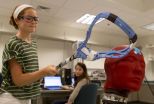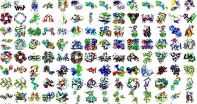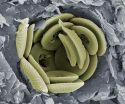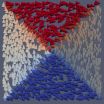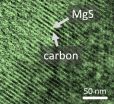(Press-News.org) Athens, Ga. - Debunking the myth of the "mean girl," new research from the University of Georgia has found that boys use relational aggression--malicious rumors, social exclusion and rejection--to harm or manipulate others more often than girls.
The longitudinal study, published online in the journal Aggressive Behavior, followed a cohort of students from middle to high school and found that, at every grade level, boys engaged in relationally aggressive behavior more often than girls.
A team led by UGA professor Pamela Orpinas analyzed data collected from 620 students randomly selected from six northeast Georgia school districts. Students who participated in the study completed yearly surveys, which allowed the UGA researchers to identify and group them in distinct trajectories for relational aggression and victimization as they progressed from grade six to 12.
"Overall, we found relational aggression to be a very common behavior. Almost all of the students surveyed, 96 percent, had passed a rumor or made a nasty comment about someone over the course of the seven-year study," said Orpinas, a professor of health promotion and behavior in the College of Public Health.
Experiences of victimization were found to be universal as well. Over 90 percent of the students reported that they had been victims of relational aggression at least once.
The analysis found that students followed three developmental trajectories of perpetration and three similar trajectories of victimization--low, moderate and high declining (that is, very high in middle school and declining in high school). When examining how these trajectories differed by gender, the data revealed some unexpected results. Significantly more boys than girls fell into the two higher trajectories for relational aggression perpetration, while more girls than boys fell into the two higher trajectories for victimization.
"We have books, websites and conferences aimed at stopping girls from being aggressive, as well as a lot of qualitative research on why girls are relationally aggressive," Orpinas said. "But oddly enough, we don't have enough research on why boys would be relationally aggressive because people have assumed it's a girl behavior."
Studies on relational victimization are uncharted territory in scientific literature, Orpinas explained. Much more research is needed to understand why girls are more likely than boys to be targets of relational aggression or to perceive certain acts as aggressive.
While the study may call for more scholarship on "mean boys" and why they behave the way they do, Orpinas said, the findings ultimately emphasize a need to include boys and girls equally in programs aimed at reducing relational aggression.
"In the end, I think we need to ask how we can focus on increasing the positive interactions among kids rather than the negative ones," she said, "because the kids that students admire are often the ones who are fun and positive about others."
INFORMATION:
The article was co-authored by Caroline McNicholas, a doctoral student in the UGA health promotion and behavior department, and Lusine Nahapetyan, an assistant professor of kinesiology and health studies at Southeastern Louisiana University.
The paper, published in Aggressive Behavior, is available online at http://onlinelibrary.wiley.com/doi/10.1002/AB.21563/abstract.
PROVIDENCE, R.I. [Brown University] -- Lacrosse players swing hard, which is why errant stick blows are the leading cause of concussion in girls' and women's lacrosse. In a new study, researchers measured how much the worst blows accelerate the head and how much different kinds of headgear could reduce those accelerations.
Girls' and women's lacrosse is a different game from the version played by males, said Joseph Crisco, the Henry Frederick Lippitt Professor of Orthopaedic Research in the Alpert Medical School of Brown University and a researcher at Rhode Island Hospital. ...
A DRUG that could reduce the harmful side-effects of 'binge drinking', especially by teenagers, has been successfully developed and tested by a team of European scientists, including the University of Huddersfield's Professor Mike Page and Dr Karl Hemming. There is also the potential for new ways to treat Alzheimer's and other neurological diseases that damage the brain.
The key to the breakthrough is a compound developed by Professor Page and colleagues at the University of Huddersfield which is named ethane-beta-sultam. This is a taurine 'pro-drug' - an effective ...
Knowledge of the three-dimensional structures of proteins is essential for understanding biological processes.
Structures help to explain molecular and biochemical functions, visualize details of macromolecular interactions, facilitate understanding of underlying biochemical mechanisms and define biological concepts.
The human genome and follow-up sequencing projects have revolutionized biology and medicine; structural genomic programmes have developed and applied structure-determination pipelines to a wide range of protein targets, facilitating the visualization of ...
A study of ancient marine algae, led by the University of Southampton, has found that climate change affected their growth and skeleton structure, which has potential significance for today's equivalent microscopic organisms that play an important role in the world's oceans.
Coccolithophores, a type of marine algae, are prolific in the ocean today and have been for millions of years. These single-celled plankton produce calcite skeletons that are preserved in seafloor sediments after death. Although coccolithophores are microscopic, their abundance makes them key contributors ...
"A quantum computer may be thought of as a 'simulator of overall Nature," explains Fabio Franchini, a researcher at the International School for Advanced Studies (SISSA) of Trieste, "in other words, it's a machine capable of simulating Nature as a quantum system, something that classical computers cannot do". Quantum computers are machines that carry out operations by exploiting the phenomena of quantum mechanics, and they are capable of performing different functions from those of current computers. This science is still very young and the systems produced to date are ...
Subliminal visual cues are words, pictures or symbols which are unidentifiable in someone's conscious.
Conducted by Professor Samuele Marcora in collaboration with colleagues at Bangor University, the research discovered that athletes undergoing endurance exercise who were presented with positive subliminal cues, such as action-related words, including 'go' and 'energy', or were shown happy faces, were able to exercise significantly longer compared to those who were shown sad faces or inaction words.
The words and faces appeared on a digital screen - placed in front ...
Researchers at DESY have used high-speed photography to film one of the candidates for the magnetic data storage devices of the future in action. The film was taken using an X-ray microscope and shows magnetic vortices being formed in ultrafast memory cells. Their work, which has been reported by the scientists surrounding Dr. Philipp Wessels of the University of Hamburg in the journal Physical Review B, provides a better understanding of the dynamics of magnetic storage materials. Magnetic memory cells are found in every computer hard drive.
"Our images allow us to observe ...
Group mindfulness treatment is as effective as individual cognitive behavioural therapy (CBT) in patients with depression and anxiety, according to a new study from Lund University in Sweden and Region Skåne. This is the first randomised study to compare group mindfulness treatment and individual cognitive behavioural therapy in patients with depression and anxiety in primary health care.
The researchers, led by Professor Jan Sundquist, ran the study at 16 primary health care centres in Skåne, a county in southern Sweden. They trained two mindfulness instructors, ...
27 November 2014 - Anopheles mosquitoes are responsible for transmitting human malaria parasites that cause an estimated 200 million cases and more than 600 thousand deaths each year. However, of the almost 500 different Anopheles species, only a few dozen can carry the parasite and only a handful of species are responsible for the vast majority of transmissions. To investigate the genetic differences between the deadly parasite-transmitting species and their harmless (but still annoying) cousins, an international team of scientists, including researchers from the University ...
This news release is available in German.
The Helmholtz Institute Ulm (HIU) established by Karlsruhe Institute of Technology (KIT) is pushing research relating to batteries of the next and next-but-one generations: A research team has now developed an electrolyte that may be used for the construction of magnesium-sulfur battery cells. With magnesium, higher storage densities could be achieved than with lithium. Moreover, magnesium is abundant in nature, it is non-toxic, and does not degrade in air. The new electrolyte is now presented in the journal "Advanced Energy ...

